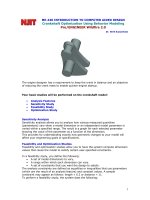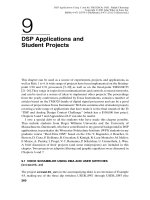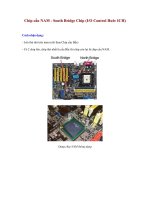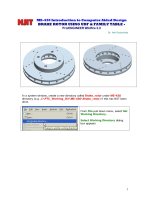Tài liệu PDA Robotics - Using Your Personal Digital Assistant to Control Your Robot ppt
Bạn đang xem bản rút gọn của tài liệu. Xem và tải ngay bản đầy đủ của tài liệu tại đây (2.84 MB, 256 trang )
PDA Robotics
PDA 00 5/28/03 8:19 AM Page i
This page intentionally left blank.
PDA Robotics
Using Your Personal Digital Assistant
to Control Your Robot
Douglas H. Williams
McGraw-Hill
New York Chicago San Francisco Lisbon London Madrid
Mexico City Milan New Delhi San Juan Seoul
Singapore Sydney Toronto
PDA 00 5/28/03 8:19 AM Page iii
Copyright © 2003 by The McGraw-Hill Companies, Inc. All rights reserved. Manufactured in the
United States of America. Except as permitted under the United States Copyright Act of 1976, no part
of this publication may be reproduced or distributed in any form or by any means, or stored in a data-
base or retrieval system, without the prior written permission of the publisher.
0-07-143403-8
The material in this eBook also appears in the print version of this title: 0-07-141741-9
All trademarks are trademarks of their respective owners. Rather than put a trademark symbol after
every occurrence of a trademarked name, we use names in an editorial fashion only, and to the benefit
of the trademark owner, with no intention of infringement of the trademark. Where such designations
appear in this book, they have been printed with initial caps.
McGraw-Hill eBooks are available at special quantity discounts to use as premiums and sales pro-
motions, or for use in corporate training programs. For more information, please contact George
Hoare, Special Sales, at or (212) 904-4069.
TERMS OF USE
This is a copyrighted work and The McGraw-Hill Companies, Inc. (“McGraw-Hill”) and its licensors
reserve all rights in and to the work. Use of this work is subject to these terms. Except as permitted
under the Copyright Act of 1976 and the right to store and retrieve one copy of the work, you may not
decompile, disassemble, reverse engineer, reproduce, modify, create derivative works based upon,
transmit, distribute, disseminate, sell, publish or sublicense the work or any part of it without
McGraw-Hill’s prior consent. You may use the work for your own noncommercial and personal use;
any other use of the work is strictly prohibited. Your right to use the work may be terminated if you
fail to comply with these terms.
THE WORK IS PROVIDED “AS IS”. McGRAW-HILL AND ITS LICENSORS MAKE NO GUAR-
ANTEES OR WARRANTIES AS TO THE ACCURACY, ADEQUACY OR COMPLETENESS OF
OR RESULTS TO BE OBTAINED FROM USING THE WORK, INCLUDING ANY INFORMA-
TION THAT CAN BE ACCESSED THROUGH THE WORK VIA HYPERLINK OR OTHERWISE,
AND EXPRESSLY DISCLAIM ANY WARRANTY, EXPRESS OR IMPLIED, INCLUDING BUT
NOT LIMITED TO IMPLIED WARRANTIES OF MERCHANTABILITY OR FITNESS FOR A
PARTICULAR PURPOSE. McGraw-Hill and its licensors do not warrant or guarantee that the func-
tions contained in the work will meet your requirements or that its operation will be uninterrupted or
error free. Neither McGraw-Hill nor its licensors shall be liable to you or anyone else for any inac-
curacy, error or omission, regardless of cause, in the work or for any damages resulting therefrom.
McGraw-Hill has no responsibility for the content of any information accessed through the work.
Under no circumstances shall McGraw-Hill and/or its licensors be liable for any indirect, incidental,
special, punitive, consequential or similar damages that result from the use of or inability to use the
work, even if any of them has been advised of the possibility of such damages. This limitation of lia-
bility shall apply to any claim or cause whatsoever whether such claim or cause arises in contract, tort
or otherwise.
DOI: 10.1036/0071434038
ebook_copyright 8.5 x 11.qxd 8/12/03 12:00 PM Page 1
Dedicated to my family, Gylian, Olivia, Rachel, and Ethan.
PDA 00 5/28/03 8:19 AM Page v
This page intentionally left blank.
vii
Introduction xv
Acknowledgments xix
1 Anatomy of a Personal Digital Assistant (PDA) 1
2 Robotic System Overview 15
3 Tools and Equipment 23
4 Infrared Communications Overview 29
5 The Electronics 43
6 Building PDA Robot 107
7 Programming the PIC16F876 Microcontroller 137
8 PDA Robot Palm OS Software Using
Code Warrior 8.0 155
Contents Summary
PDA 00 5/28/03 8:19 AM Page vii
Copyright 2003 by The McGraw-Hill Companies, Inc. Click Here for Terms of Use.
For more information about this title, click here.
9 PDA Robot Software for Pocket PC 2002
(Windows CE) 169
10 The PDA Robotics Command Center 195
11 Infinitely Expandable 211
Index 221
PDA Robotics
viii
PDA 00 5/28/03 8:19 AM Page viii
ix
Introduction xv
Acknowledgments xix
1 Anatomy of a Personal Digital Assistant (PDA) 1
Beneath the Cover 5
The SA-1110: An Example of ARM Architecture 7
2 Robotic System Overview 15
Major Electronic Parts 15
Microchip MCP2150 IrDA Standard
Protocol Stack Controller 15
Vishay TFDS4500 Serial Infrared Transceiver 17
PIC16F876 Microcontroller 18
L7805ACV Voltage Regulator (5 Volts) 18
L298 Dual Full-Bridge Driver 19
Sharp GP2D12 Infrared Range Finder 20
DYN2009635 20 MH and RXDMP49 11.0952 MHz
“AT” Cut Quartz Crystal Oscillator 21
Contents
PDA 00 5/28/03 8:19 AM Page ix
For more information about this title, click here.
Copyright 2003 by The McGraw-Hill Companies, Inc. Click Here for Terms of Use.
3 Tools and Equipment 23
Essential Tools and Equipment 23
Safety First 26
Where to Get Equipment 27
4 Infrared Communications Overview 29
Technical Summary of IrDA Data and IrDA Control 31
IrDA’s New Full Range of Digital Information
Exchange via Cordless IR Connections 31
Optional IrDA Data Protocols 33
IrDA Control 33
Windows CE (Pocket PC) and IrDA 35
Communication Link Speeds 36
Communication Link Turnaround Times 37
SIR Coding 39
MIR Coding 39
FIR Coding 40
VFIR Coding 40
5 The Electronics 43
System Overview 43
Setting the Baud Rate 46
The MCP2150 Connection to the IR Transceiver 47
The MCP2150 Connection to the PIC16F876
Microcontroller 49
The Motor Controller Circuit 51
The Sharp GPD12 IR Range Finder 52
Component Descriptions 53
The Vishay TFDS4500 53
The Microchip MCP2150 Plug and Play IrDA 58
MCP2150 Applications: PDA Robot 59
Crystal Oscillator/Ceramic Resonators 62
PDA Robotics
x
PDA 00 5/28/03 8:19 AM Page x
Bit Clock 63
UART Interface 63
Baud Rate 63
Transmitting 64
Receiving 64
Modulation 64
Demodulation 65
Minimizing Power 65
Returning to Device Operation 65
Network Layering Reference Model 65
IrDA Data Protocols Supported by MCP2150 66
IRDA Standard Protocol Layers 69
PDA and PDA Robot Handshake: How Devices Connect 71
Normal Disconnect Mode (NDM) 72
Discovery Mode 74
Normal Connect Mode (NCM) 76
MCP2150 Operation 76
Optical Transceiver 77
Typical Optical Transceiver Circuit 78
MCP2150 Absolute Maximum Ratings 78
PIC16F876: PDA Robot’s Microcontroller 78
PORTA and the TRISA Register 84
PORTB and the TRISB Register 87
PORTC and the TRISC Register 90
The L298 Dual Full-Bridge Driver
(PDA Robot Motor Controller) 96
Description 97
The GP2D12 IR Range Finder 102
Connecting to the Sensor 104
Operation 104
Calibration 104
Contents
xi
PDA 00 5/28/03 8:19 AM Page xi
Ambient Light 105
IR Light 105
Laser Light 106
Operation 106
6 Building PDA Robot 107
Creating the Circuit Board 107
Positive Photofabrication Process Instructions 108
Parts Lists 115
Placing and Soldering the Main Board Components 117
Placing and Soldering the Motor Controller Components 120
The Infrared Transceiver 122
The Power Connectors 123
The Battery Packs 123
The IR Range Finder 124
Cutting the Aluminum Pieces and Drilling the Holes 125
Assembling the Geared Motors 127
The Ribbon Connectors 130
The Camera (Accessory) Mount 134
7 Programming the PIC16F876 Microcontroller 137
Software Installation 138
Hardware Installation 139
General Operation 140
EPIC for DOS 141
EPIC for Windows 95/98/ME/NT/2000/XP 142
EPICWin Controls 144
The PICmicro MCU Compiler 145
The Command Line Compiler 146
The Source Code 147
Program the PIC16F876 153
PDA Robotics
xii
PDA 00 5/28/03 8:19 AM Page xii
8 PDA Robot Palm OS Software
Using Code Warrior 8.0 155
Creating the PDA Robot Project 157
9 PDA Robot Software for Pocket PC 2002
(Windows CE) 169
Microsoft eMbedded Visual C++ 3.0 Overview 170
Increased Developer Productivity 173
Simplified Debugging and Deployment 173
Comprehensive Access to the Windows CE Platform 173
Build for the Latest Windows CE Devices 174
Fast, Flexible Data Access 174
Building the PDA Robot Pocket PC Application 175
Creating the IrDA Link 177
The Wireless RF Link 186
CCeSocket::CCeSocket 188
Parameters 188
Remarks 188
OnWireless: Implementing the CPDASocket Class 189
10 The PDA Robotics Command Center 195
The Video Link 195
Motion Detection 197
Sending Data Using FTP 201
The Wireless Data Link 206
11 Infinitely Expandable 211
Global Positioning System 211
Pocket CoPilot 3.0 GPS Jacket Edition:
PCP-V3-PAQJ2 212
The TeleType GPS 212
Symbol SPS 3000 Bar Code Scanner Expansion Pack 214
Contents
xiii
PDA 00 5/28/03 8:19 AM Page xiii
Sierra Wireless AirCard 555 215
Telesurgery 216
Operations of the Future 216
Index 221
PDA Robotics
xiv
PDA 00 5/28/03 8:19 AM Page xiv
xv
The NASA Mars Sojourner rover inspired this project
( I followed the mission
with great enthusiasm and witnessed a giant leap in robotics that day
it began roaming the Martian terrain and sending images back to earth.
Though I was in awe when the Viking missions of the 1970’s were in
progress, we didn’t see that near real-time interaction with the craft
( The twin rovers
scheduled to launch May/July 2003 and land on the surface January
2004 will be something to follow ( PDA
Robot is a scaled down version of Sojourner that has a similar frame-
work, components, and functionality at a much lower cost!
The personal digital assistant is the main control unit of the robot, com-
municating with the craft’s body via a beam of infrared light and to
other machines on the wireless network. The PDA itself becomes a data
transponder. It (the PDA) is insulated and protected from the robotic
interface. It is said to be optically isolated, communicating on ripples
of light. Because of this design, no connectors are required and the soft-
ware provided will work with any Windows or PalmOS driven hand-
held PDA. I see a day when all components of a system are connec-
tionless with harmonically synchronized transistors.
I will go into the theory behind the operation of each component as
well as the practical hands-on information and processes needed to
Introduction
PDA 00 5/28/03 8:19 AM Page xv
Copyright 2003 by The McGraw-Hill Companies, Inc. Click Here for Terms of Use.
complete this project. I will also make suggestions for enhancements
and modifications to the electronic, mechanical, and software design;
enhancements that I will leave up to you to explore.
The only limit to any enhancements or changes will be that of your
imagination. This book will give you the expertise to create anything.
One of many areas that I will touch on is the smart distributed network,
where each robot can pass the information that it gains onto the “col-
lective” to be shared with other robots. For instance, if two PDA Robots
pass each other they can exchange information about a room in the
house that has been mapped, saving any duplication of effort. The
robots can synchronize to coordinate effort as well. A good example of
a coordinated autonomous effort is the idea of traffic being directed by
a computer system. In the future, I believe the key to making the world
a better place is to effectively and fully use the resources we have avail-
able. Traffic congestion on the freeways could be eliminated for years to
come without building anymore highways if it was managed properly.
Cars outfitted with sensors and wireless technology could be tied into a
central coordination system making the commute to work an enjoyable
and relaxing experience. This is something that could be achieved on a
smaller scale with this project if you take it a step further.
Artificial intelligence, self-modifying code, and the emergent behavior
of computers is a fascinating area of research that will be touched on
in this book. Emergent behavior in a system is the system’s ability to
become intelligent over and above the programming that has been
coded into it. Sometime this is seen as a behavior or unanticipated
function that is the result of the interaction between two systems. I
have seen this happen with smart digital imaging archiving software
at the medical imaging company where I currently work. One must be
careful when enabling a machine with AI to make decisions around
humans though. A “smart” robot building an office tower may decide
that the best course of action may be to remove a support beam and
put it up at a later time. But if the programmer made a mistake and
didn’t have another algorithm check the structural integrity before
approving of the decision, then the whole building would come down.
A simple coding error of “if (StructuralIntegrityOk = TRUE){
RemoveBeam(BeamNumber); }” spells disaster. The equality operator
== is mistaken for and the assignment operator =. One must ensure
that AI bots stay within safe operating parameters, are monitored
closely, and have a remote kill switch.
PDA Robotics
xvi
PDA 00 5/28/03 8:19 AM Page xvi
Enabling the machine with a sense of sight is another topic that will
be explored and explained. PDA Robot can “see” through the use of an
infrared range finder and wireless video camera. The machine vision
algorithms used in this project interpret the surroundings and send
feedback to the robot. The ability to send video data into the wireless
network through a video capture card open the “window” to a virtual
presence. Amazing things are being done today with this technology.
Doctors can perform surgery from any point on earth to another; we
can be there from here!
One interesting point about the IR range detector is the fact that the
pulsed beam of IR light is highly visible to a modern IR target locking
system deployed by most modern military equipment. This could be
an advantage or a drawback. The invisible infrared beam can provide
a good source for a night vision video camera, in fact most low cost
video cameras will be able to detect the beam from the front. If you
have a video camera give it a try! I will discuss other methods of data
transmission (visible light) and range finding (invisible). If we tap into
the this range finder and pulse the light beam and use a telescope, we
can create a very long range point-to-point communication device
ideal for ground to air operations. Something I will leave you to exper-
iment with.
Once PDA Robot is on the network it is essentially an internet appli-
ance.
My hope is that this project will give you the knowledge and experi-
ence to create any electronic device that you can dream up. All the
information is out there—just follow the links from a good search
engine. Automation, ordering over the Web, and courier service allows
everything in this project to be delivered to your door. Please experi-
ment with the design—I’ve designed an amphibious and airborne
body that the circuitry can be “snapped” into. I hope you evolve this
design once you become familiar with it.
If this technology is applied in the same spirit as the space program
and with the ethics of modern medicine, then I can see great things
evolving from it
For online updates, source code, and other useful files that will aid
you in completing PDA Robot, please visit www.pda-robotics.com.
Douglas Williams
Introduction
xvii
PDA 00 5/28/03 8:19 AM Page xvii
This page intentionally left blank.
xix
Thanks goes out to everyone along the way made this book possible,
especially my brothers, Karl Williams and Geoff Williams, whom
without I would have not endeavored to write this book. Thanks to my
parents, Gord and Ruth Williams, for all their support over the years.
Thanks to my family for putting up with my late nights and lost week-
ends.
Thanks to Judy Bass and Patricia Wallenburg, for their patience and
the fabulous job they have done putting the whole thing together.
Special thanks to my friends and colleagues who have inspired me
along the way: Michael Foote, Bob Lazic, Paul Stienbach, Dave Huson,
Dave Smith, Stephane MacMaster, John Lammers, Julius Avelar, Erkan
Akyuz, Desh Sharma, Tim Jones, Tom Cloutier, Paul McNally, Barry
Reville, Bart Domzy, James Chase, Stephen Kingston, John Sanio, Kim
Martin, Clark MacDonald, Peter Madziak Stephen Frederick, Derrick
Barnes, Darren Tarachan, Steve Spicer, Mathew Sullivan, John
Kominar, Grant E, Paul Barton, Eric Peterson, Larry Williamson, and
anyone I may have left off of this list.
Thanks to Rebecca Tollen for the information on telesurgery and
Microsoft, Palm OS, MicroChip, HVW Tech, Sharp, ST Microelectronics,
Micro Engineering Labs, Protel, Intel, Intuitive Surgical, Handspring, HP,
and Compaq for helping to make this project possible.
Acknowledgments
PDA 00 5/28/03 8:19 AM Page xix
Copyright 2003 by The McGraw-Hill Companies, Inc. Click Here for Terms of Use.
This page intentionally left blank.
PDA Robotics
PDA 00 5/28/03 8:19 AM Page xxi
This page intentionally left blank.
1
The power is sitting in the palm of your hand. The technology exists
today to bring your world to you wherever you happen to be. Wireless
technology, a handful of electronic components, a small handheld
computer, and little software to glue everything together is all that is
needed to be “virtually” enabled. The culmination of this project will
provide you with the know-how to create a robotic device that can be
controlled through your PDA from anywhere over the World Wide
Web or allowed to roam autonomously using its PDA “brain.”
Why use a PDA? These devices are small and powerful, leveraging the
best technology that can be offered today in the palm of your hand.
They make for perfect robotic controllers, as they can be easily expand-
ed through their expansion slots. If you need a wireless network or a
global positioning system, simply slide in the card. Increasingly, they
have the wireless technology built into them, such as Bluetooth or dig-
ital/analog cellular phone technology, as seen in Figure 1.1. These
devices have rich application programming interfaces (APIs) that can
be used to create powerful end user applications, capitalizing on the
device capabilities, as shown in this book. The Infrared Data
Association (IrDA) functions contained in both the Windows CE and
Palm OS APIs are pure abstractions to the actual infrared transceivers
built into the PDA. For example, socket (AF_IRDA, SOCK_STREAM,
NULL) and IrOpen (irref, irOpenOptSpeed115200) are the Windows CE
and Palm OS API calls used to initiate the IrDA Data link to the PDA
Anatomy of a
Personal Digital
Assistant (PDA)
1
PDA 01 5/30/03 9:09 AM Page 1
Copyright 2003 by The McGraw-Hill Companies, Inc. Click Here for Terms of Use.
Robot. The source included will explain in detail how to accomplish a
data link used to send and receive information.
Once the link is established, users can virtually project themselves
anywhere. A doctor can perform surgery on a patient thousands of
miles away. You can roam around your house on PDA Robot from your
hotel room, cottage, or even flying 60,000 feet above the earth. This
book will give you the tools and know-how to transform this project
into anything. Explaining the schematic design, circuit board manu-
facturing, embedded software for the microchip, mechanical design
and the software source code for the world’s two most popular PDA
(handheld) operating systems, this book will take you on a tour of
today’s specialized electronic microchips and the inner workings of
PDA operating systems.
PDA (personal digital assistant) is a term for any small mobile handheld
device that provides computing and information storage and retrieval
capabilities for personal or business use, often for keeping schedule cal-
endars and address book information handy. The term handheld is a
synonym. Many people use the name of one of the popular PDA prod-
ucts as a generic term. These include Compaq/Hewlett-Packard’s IPAQ
and 3Com’s Palm devices, such as the Palm Pilot and m505.
PDA Robotics
2
Figure 1.1
Integrated wireless
PDAs.
PDA 01 5/30/03 9:09 AM Page 2









